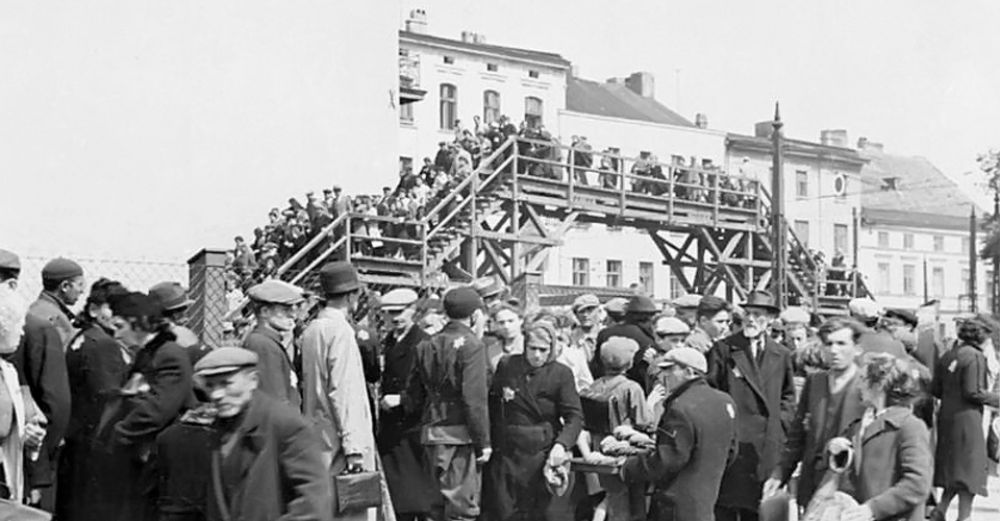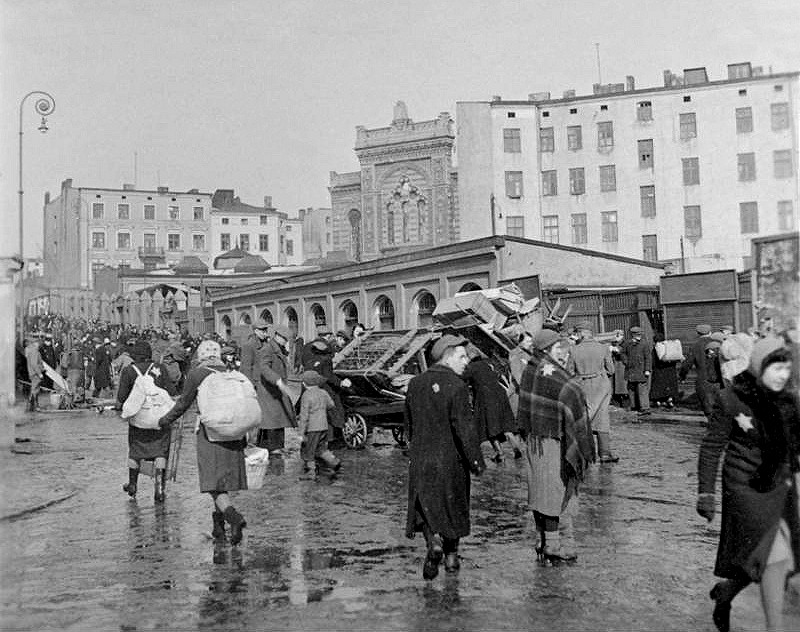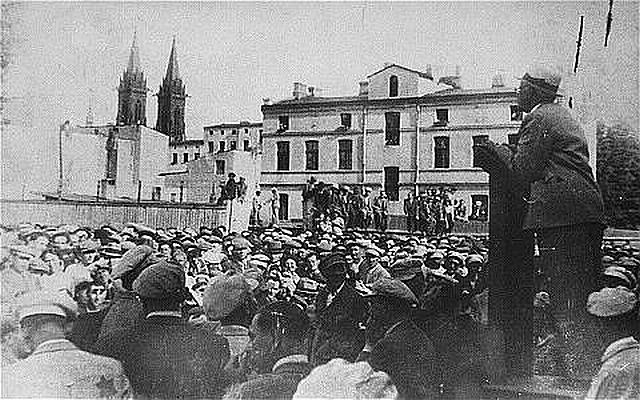- News
- Events
- Oneg Shabbat
- Collections
- Research
- Exhibitions
- Education
- Publishing Department
- Genealogy
- About the Institute
- Bookstore


78 years ago, on February 8th, Germans created ghetto in Łódź. As soon as on 30th April of the same year it was isolated from the rest of the city. In spring 1941 its isolation was even deepened by placing double barbed wire fence and enlarging the number of police forces, whose members was supposed to shoot everyone who tried to approach the border of the ghetto. After eliminating mail communication, the beginning of 1942 meant total isolation of the population of this part of the town unmatched in other ghettos.
- Łódź would be the most impenetrable ghetto in Europe – remembers a survivor Eva Libitzky who was locked in it with her family. – The Germans demolished all the houses around it, leaving a treacherous no-man’s land between the fence and the Aryan side. In contrast with Warsaw, for example, where at least some contact could be made with Polish freedom fighters, once our ghetto was sealed, no food or weapons were smuggled in and virtually no Jews escaped. Two of the city’s major arteries, Zgierska and Limanowskiego Streets, did run through the ghetto and their streetcars carried Poles and Volksdeutsche. But barbed wire separated us from these roads, too, and if we needed to cross them we had to use newly built wooden footbridges, twenty-five feet above ground. No measure was spared to separate us from the rest of Łódź. This extremely tight control is the main reason we never fought back. Even the lack of sewers deprived us of the route for smugglers and escapees such as existed in the Warsaw ghetto.[1]
In June 1940 in the Łódź ghetto approx. 200,000 people was held. Between 17th September and 4th December 1941 transports of Jews from Germany (from Berlin, Düsseldorf, Duisburg, Cologne, Frankfurt a/Main, Hamburg), Austria (mainly from Vienna), Czech (from Prague), Holland and Luxemburg were coming to Łódź ghetto. Also 15,000 skilled workers were brought there from Reichsgau Wartheland.
Chairman of the Łódź Judenrat, Chaim Rumkowski, known as the “king of the ghetto”, introduced an authoritarian rules and soon eliminated most of the structures remaining beyond his supervision (house committees, displaced persons compatriot’s associations). Formally given relatively wide range of the autonomy was used to, among other things, to extend administration and police force, including secret service which aim was to counteract the opposition. In Łódź ghetto was executed the idea of “fair distribution of distress” and “salvation through working for the Germans”.
- Rumkowski saw how vulnerable we were – remembers Eva Libitzky. — Caught in this vise, we’d either be starved to death or sent off to a horrible fate in the east. So he struck a unique deal with the Nazis that would last for the next four and a half years: He proposed that the ghetto, with its many industrial buildings and skilled artisans, become a manufacturing hub for Germany. Factories and workshops would churn out war materiel as well as goods for civilians, and in return the entire Jewish community would receive food and be allowed to live. There was no other way we could survive, he was certain. »Our only path is work«, he declared repeatedly. (…) To some extent he succeeded. Under threat of death, we became one of the largest industrial centers of the Reich, operating for years after the liquidation of the ghettos of Warsaw, Cracow, Białystok, and most other cities. [2]

At the same time ghetto elite of people connected with Rumkowski was formed. Its members, called jachsens, were allowed to stay at the villas and guesthouses in Marysin. Gradually the ghetto transformed into the biggest slave labor camp. In the beginning of 1943 there were 119 manufacturing plants in which over 89% of the population of approx. 87,000 people worked. The benefits the ghetto created for the supply of the Wehrmacht and German companies, as well as the profits coming from the ghetto to occupier’s administration, resulted in the fact that the Łódź ghetto was liquidated as the last in occupied Poland. The resistance against Germans came from the Communist Joined Union Committee which in 1940 transformed into the Union’s Left. Its members recruited mostly from left-wing labor unions (mainly members of the Bund, Poale Zion-Left and former members of the Communist Party of Poland.) Its activities focused mainly on sabotaging labor for the occupier. There were also few protests and street actions (30th June 1940, end of August and 8th September 1940; January and March 1941).

However, one of the most horrifying events that took place in the history of the ghetto in Łódź was the speech by Rumkowski in which on 4th September 1942, standing on a makeshift stage situated on, he addressed the parents of the ghetto. It was the consequence of the new order in which Germans demanded that 20,000 Jewish children must be handed over for deportation.
Rumkowski said:
- A grievous blow has struck the ghetto. They [the Germans] are asking us to give up the best we possess – the children and the elderly. I was unworthy of having a child of my own, so I gave the best years of my life to children. I’ve lived and breathed with children, I never imagined I would be forced to deliver this sacrifice to the altar with my own hands. In my old age, I must stretch out my hands and beg: Brothers and sisters! Hand them over to me! Fathers and mothers: Give me your children! [2]
Dramatic reaction of Jews gathered on the square and later on all the inhabitants of the ghetto, who were rightfully suspecting that children will be deported and their fate sealed, was reported in his memoir by Michał Mosze Chęciński:
- From the chests of thousands of people came out poignant scream, despair of mothers and fathers could almost be physically touched. On this day the whole ghetto cried, from its every corner came laments to God. [3]
According to Andrzej Rukowiecki, between 5th and 12th 1942 “to extermination camp in Chełmno by the river Ner 15,681 people were deported – children under 10 years, sick and elderly over 65 years-old”. [4] Deportation action was accompanied by the ban on leaving homes by Jews issued by Germans, so-called “Great Szpera” (ger. Allgemeine Gehsperre).
Deportations of 1942 ultimately put an end to any forms of resistance. During the indirect extermination in Łódź ghetto, primarily due to famine and diseases died: in 1940 – 6 197 people, in 1941 – 11 378. During the “Operation Reinhard”, from the middle of January to September 1942, approx. 116,000 of ghetto inhabitants were murdered in Chełmno extermination camp.
On 1st June 1944 in Łódź ghetto still lived 76 701 Jews of which from the late June 1944 to September 1944 60,000 were deported to Auschwitz-Birkenau, 5,000 to camps in Stutthof and Ravensbrück. These deportations marked the liquidation of the last ghetto in occupied Poland. Left in Łódź, as so-called ordinal brigade (ger. Aufräumungskommando) were approx. 880 people. Germans intended to murder them all, but in the last moment members of the brigade managed to hide. On 19th January 1945, when the Red Army liberated the city, there were 877 Jews in Łódź.
Footnotes:
[1] Eva Libitzky, Fred Rosenbaum, Out on a Ledge. Enduring the Lodz Ghetto, Auschwitz, and Beyond, Wicker Park Press, River Forest 2010, s. 43–44.
[2] Simone Schweber, Debbie Findling, Teaching the Holocaust (Google Book, preview). Ghettoization (Torah Aura Productions 2007). s. 107. (dostęp 24 marca 2015).
[3] Andrzej Rukowiecki, Łódź. 1939–1945. Kronika okupacji, Księży Młyn, Łódź 2012, s. 125.
[4] Ibidem.
Bibliography:
Rafał Żebrowski, Getto łódzkie, w: Polski Słownik Judaistyczny.
Eva Libitzky, Fred Rosenbaum, Out on a Ledge. Enduring the Lodz Ghetto, Auschwitz, and Beyond, Wicker Park Press, River Forest 2010.
Andrzej Rukowiecki, Łódź. 1939–1945. Kronika okupacji, Księży Młyn, Łódź 2012.
Simone Schweber, Debbie Findling, Teaching the Holocaust (Google Book, preview). Ghettoization (Torah Aura Productions 2007).